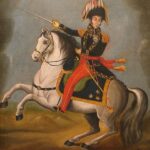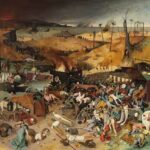![]() This year marked the end of a period known in American history as the Roaring Twenties after the Wall Street Crash of 1929 ushered in a worldwide Great Depression. In the Americas, an agreement was brokered to end the Cristero War, a Catholic counter-revolution in Mexico. The Judicial Committee of the Privy Council, a British high court, ruled that Canadian women are persons in the Edwards v. Canada (Attorney General) case. The 1st Academy Awards for film were held in Los Angeles, while the Museum of Modern Art opened in New York City. The Peruvian Air Force was created.
This year marked the end of a period known in American history as the Roaring Twenties after the Wall Street Crash of 1929 ushered in a worldwide Great Depression. In the Americas, an agreement was brokered to end the Cristero War, a Catholic counter-revolution in Mexico. The Judicial Committee of the Privy Council, a British high court, ruled that Canadian women are persons in the Edwards v. Canada (Attorney General) case. The 1st Academy Awards for film were held in Los Angeles, while the Museum of Modern Art opened in New York City. The Peruvian Air Force was created.
In Asia, the Republic of China and the Soviet Union engaged in a minor conflict after the Chinese seized full control of the Manchurian Chinese Eastern Railway, which ended with a resumption of joint administration. In the Soviet Union, General Secretary Joseph Stalin expelled Leon Trotsky and adopted a policy of collectivization. The Grand Trunk Express began service in India. Rioting between Muslims and Jews in Jerusalem over access to the Western Wall took place in the Middle East. The centenary of Western Australia was celebrated. The Afghan Civil War, which started in November in the preceding year, continued until October.
The Kellogg–Briand Pact, a treaty renouncing war as an instrument of national policy, went into effect. In Europe, the Holy See and the Kingdom of Italy signed the Lateran Treaty. The Idionymon law was passed in Greece to outlaw political dissent. Spain hosted the Ibero-American Exposition which featured pavilions from Latin American countries. The German airship LZ 127 Graf Zeppelin flew around the world in 21 days.
Literature, arts, and entertainment
Main article: 1929 in the arts
Literature of the time reflected the memories many harbored of the horrors of World War I. A major seller was All Quiet on the Western Front by Erich Maria Remarque. Remarque was a German who had fought in the war at age eighteen and been wounded in the Third Battle of Ypres. He stated that he intended the book to tell the story “of a generation of men who, even though they may have escaped its shells, were destroyed by the war.” Another 1929 book reflecting on World War I was Ernest Hemingway‘s A Farewell to Arms, as well as Good-Bye to All That by Robert Graves.[41] In lighter media, a few stars of the comic industry made their debut, including Tintin, a comic book character created by Hergé, who would appear in over 200 million comic books in 60 languages. Popeye, another comic strip character created by Elzie Crisler Segar, also appeared in this year.
Within the film industry, on May 16 the 1st Academy Awards were presented at the Hollywood Roosevelt Hotel, with Wings winning Best Picture. Also, Hallelujah! became the first Hollywood film to contain an entirely black cast, and Atlantic, a film about the Titanic, is an early sound-on-film movie. The arts were in the midst of the Modernist movement, as Pablo Picasso painted two cubist works, Woman in a Garden and Nude in an Armchair, during this year. The surrealist painters Salvador Dalí and René Magritte completed several works, including The First Days of Spring and The Treachery of Images. On November 7 in New York City, the Museum of Modern Art opened to the public. The latest in modern architecture was also represented by the Barcelona Pavilion in Spain, and the Royal York Hotel in Toronto, at its completion the tallest building in the British Empire.
Science and technology
Main article: 1929 in science
The year saw several advances in technology and exploration. On June 27 the first public demonstration of color TV was held by H. E. Ives and his colleagues at Bell Telephone Laboratories in New York. The first images were a bouquet of roses and an American flag. A mechanical system was used to transmit 50-line color television images between New York and Washington. The BBC broadcast a television transmission for the first time. By November, Vladimir Zworykin had taken out the first patent for color television. On November 29, Bernt Balchen, U.S. Admiral Richard Byrd, Captain Ashley McKinley, and Harold June, became the first to fly over the South Pole. Within the year, Britain, Australia and New Zealand began a joint Antarctic Research Expedition, and the German airship Graf Zeppelin began a round-the-world flight (ended August 29). This year Ernst Schwarz describes Bonobo (Pan paniscus) as a different species from common chimpanzee (Pan troglodytes), both closely related phylogenetically to human beings.







